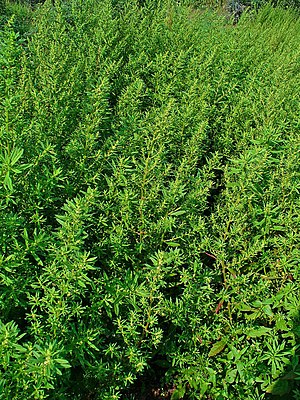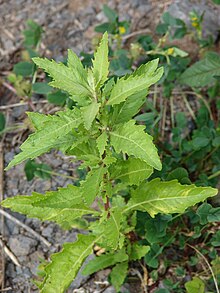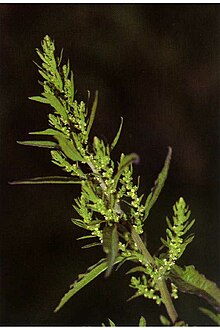Mexican goosefoot
| Mexican goosefoot | ||||||||||||
|---|---|---|---|---|---|---|---|---|---|---|---|---|

Mexican goosefoot ( Dysphania ambrosioides ) |
||||||||||||
| Systematics | ||||||||||||
|
||||||||||||
| Scientific name | ||||||||||||
| Dysphania ambrosioides | ||||||||||||
| ( L. ) Mosyakin & Clemants |
The Mexican goose foot ( Dysphania ambrosioides ), also called epazote , fragrant goose foot , Mexico goose foot , Mexican grape tea or Jesuit tea , is a species of plant in the foxtail family (Amaranthaceae). This intensely smelling plant is used as a medicinal plant and spice .
description
Vegetative characteristics
Dysphania ambrosioides is an annual herbaceous plant that sometimes lasts a few years and is covered with single-row multicellular hairs and glandular hairs and exudes an intense aromatic smell (of lemon, savory or mint). The upright or ascending, striped stems are strongly branched with delicate branches at heights of 0.3 to 1 (rarely up to 1.5) meters.
The aromatic leaves are usually stalked up to 18 mm long, the top are often sessile. The leaf blade has a length of mostly 2 to 8 (up to 15) cm and a width of mostly 0.5 to 4 (up to 5.5) cm. The spreading shape is ovate-lanceolate to lanceolate with a wedge-shaped base. The leaf margin is irregularly serrated or roughly serrated, the upper leaves often have entire margins.
Inflorescence and flower
The 3 to 7 cm long, spike-like inflorescences are composed of sitting, spherical, ball-shaped partial inflorescences with a diameter of 1.5 to 2.3 mm; these each consist of three to five flowers in the axilla of a foliage-like bract with a length of 0.3 to 2.5 cm.
The small, yellow hermaphrodite (occasionally female) flowers have a perimeter of (rarely three) four to five tepals that are fused together over about half their length . With a length of 0.7 to 1 mm, they are egg-shaped with a blunt tip, rounded on the back and glandular hair. There are four to five stamens and three protruding stigmas.
The flowering period extends from June to September. Pollination is usually done by the wind, but is also possible by self-pollination.
Fruit and seeds
At the time of fruiting, the flower envelope surrounds the fruit. The wrinkled to smooth pericarp does not touch the seed. The reddish-brown to reddish-black, horizontal or vertical seed is egg-shaped with an indistinct margin at a height of 0.6 to 1 mm and a diameter of 0.4 to 0.5 mm. The seed coat is smooth or wrinkled.
Chromosome number
The chromosome number is 2n = 32. The basic chromosome number of the genus Dysphania of x = 8 shows that this species is tetraploid . Chromosome numbers of 16, 36 and 48 are also given in other sources.
Photosynthetic pathway
The Mexican goosefoot is a C 3 plant with normal leaf anatomy .
ingredients
The leaves and seeds contain up to 2% of an essential oil with the main ingredient ascaridol , a monoterpene peroxide .
ecology
The Mexican goosefoot is a food plant for butterfly caterpillars: mini-sac carriers of the genus Coleophora , the thick-headed butterflies Pholisora catullus and Staphylus mazans and the owl butterflies Amyna octo and Rachiplusia ou feed on this species.
Occurrence
Dysphania ambrosioides is native to the tropical and subtropical North and South America . It has settled in warm areas worldwide through planting or naturalization. In Europe this species is naturalized in all warm temperate regions. Since it is not winter hardy, it only grows in specially protected places in the lowlands in Central Europe.
The Mexican goose foot first appeared in Germany in the 18th century. Today this warmth-loving neophyte grows rarely and inconsistently in Central Europe as a ruderal plant in debris weeds, on garbage dumps or on banks (in the system of plant sociology: Sisymbrietea officinalis) on very nutrient-rich sandy and loamy soils. In southern Europe it is a species of the Chenopodion muralis association.
Systematics
Dysphania ambrosioides belongs within the genus Dysphania to the section Adenois (Moq.) Mosyakin & Clemants .
The first publication was made of this kind in 1753 by Carl Linnaeus under the name Chenopodium ambrosioides in Species Plantarum . It was placed in the genus Dysphania in 2002 by Sergei Mosyakin and Steven Clemants .
Other synonyms for Dysphania ambrosioides (L.) Mosyakin & Clemants are: Ambrina ambrosioides (L.) Spach , Atriplex ambrosioides (L.) Crantz , Blitum ambrosioides (L.) Beck , Chenopodium ambrosioides var. Suffruticosum (Willd.) Graebn. and Teloxys ambrosioides (L.) WAWeber and Chenopodium integrifolium Vorosch. and Chenopodium suffruticosum Willd. . A name that is often misused is Chenopodium anthelminticum .
In the past, Chenopodium ambrosioides var. Anthelminticum was also classified in this species, but according to recent studies it is listed as a separate species of worm seed goosefoot ( Dysphania anthelmintica (L.) Mosyakin & Clemants ).
Common names and etymology
The Mexican goosefoot has numerous German names, such as epazote, Mexican tea, Mexican tea herb, Mexican ragweed, tea goose foot, ragweed, fragrant goose foot, Mexico goose foot, scented goose foot, Mexican goosefoot, Jesuit tea and Mexican, Jesuit tea and Mexican grape tea Tea ( Austria ) and Merwet ( Transylvania ).
The word epazote comes from the Nahuatl and is made up of epatl for skunk and sotl , synonymous with sweat or dirt. It indicates the intense smell of the herb. The word Paico , derived from the Quechua language , is also common in South America .
use
Spice and tea plant
In Mexican cuisine , fresh or dried epazote leaves are particularly used as a gas-reducing spice for bean dishes . Epazote is mostly used in southern Mexico. The leaves are prepared as "Mexican tea". Raw leaves should only be consumed in small quantities as the essential oil is toxic. The plant can cause dermatitis and other allergic reactions . The seeds are also edible when cooked. To remove the saponins , they should be soaked in water overnight before boiling and rinsed well.
Medicinal plant
The Mexican goosefoot is a medicinal plant that is used in many ways . Because of the disinfecting effect of ascaridol, adding epazote leaves to cooked beans reduces the flatulence that otherwise occurs easily . An infusion of the leaves is used for digestive problems, colic or stomach pain ( carminative ).
It is also effective against coughs (anti- asthmatic ). Externally as an envelope, it is used for hemorrhoids , insect bites or snakebites and for wound healing. It has a pain relieving effect ( analgesic ) and against fungal diseases ( antifungal ).
The worm seed goosefoot or wormweed, which used to belong to this species, is particularly rich in ascaridole. Its seeds or the essential oil obtained from them have been used in folk medicine for centuries as a worming agent and are also effective against dysentery ( dysentery ). Because of its toxicity, this treatment should be carried out under medical supervision and not in pregnant women.
Other uses
The essential oil from the plant is also used in cosmetic products . The plant has an insecticidal effect and is used as a repellent against mosquitoes, as an additive in fertilizer against insect larvae and against lice and bed bugs. It also serves as a coloring plant , with golden-green shades being achieved.
literature
- Steven E. Clemants, Sergei L. Mosyakin: Dysphania. In: Flora of North America Editorial Committee (Ed.): Flora of North America North of Mexico . Volume 4: Magnoliophyta: Caryophyllidae, part 1 . Oxford University Press, New York / Oxford a. a. 2003, ISBN 0-19-517389-9 , Dysphania ambrosioides , p. 270 (English, online ). (Sections Description and Systematics)
- Gelin Zhu, Sergei L. Mosyakin, Steven E. Clemants: Chenopodiaceae. In: Wu Zhengyi, Peter H. Raven, Deyuan Hong (Eds.): Flora of China . Volume 5: Ulmaceae through Basellaceae . Science Press / Missouri Botanical Garden Press, Beijing / St. Louis 2003, ISBN 1-930723-27-X , Dysphania ambrosioides , pp. 377 (English, online ). (Sections Description, Common Name)
Individual evidence
- ↑ a b c d e Gernot Katzer's Spice Pages .
- ↑ a b c Chenopodium ambrosioides in Biolflor.
- ↑ Chenopodium ambrosioides , chromosome number at Tropicos.org. Missouri Botanical Garden, St. Louis
- ↑ a b c Erich Oberdorfer : Plant-sociological excursion flora . With the collaboration of Theo Müller. 5th, revised and expanded edition. Eugen Ulmer, Stuttgart (Hohenheim) 1983, ISBN 3-8001-3429-2 , pp. 342 .
- ↑ Gudrun Kadereit, Evgeny V. Mavrodiev, Elizabeth H. Zacharias, Alexander P. Sukhorukov: Molecular phylogeny of Atripliceae (Chenopodioideae, Chenopodiaceae): Implications for systematics, biogeography, flower and fruit evolution, and the origin of C4 Photosynthesis. In: American Journal of Botany. Volume 97, No. 10, 2010, pp. 1664-1687.
- ↑ Monzote L, Geroldinger G, Tonner M, Scull R, De Sarkar S, Bergmann S, Bacher M, Staniek K, Chatterjee M, Rosenau T, Gille L: Interaction of ascaridole, carvacrol, and caryophyllene oxide from essential oil of Chenopodium ambrosioides L. with mitochondria in Leishmania and other eukaryotes. , Phytother Res. 2018 Sep; 32 (9): 1729-1740. PMID 29672979
- ^ Gaden S. Robinson, Phillip R. Ackery, Ian J. Kitching, George W. Beccaloni, Luis M. Hernández: Entry at HOSTS - A Database of the World's Lepidopteran Hostplants .
- ^ A b Dysphania ambrosioides in the Germplasm Resources Information Network (GRIN), USDA , ARS , National Genetic Resources Program. National Germplasm Resources Laboratory, Beltsville, Maryland. Retrieved December 7, 2011.
- ↑ a b c Pertti Uotila: Chenopodiaceae (pro parte majore) . Dysphania ambrosioides . In: Euro + Med Plantbase - the information resource for Euro-Mediterranean plant diversity. Berlin 2011, accessed December 7, 2011.
- ↑ Carl von Linné: Species Plantarum. Volume 1, Lars Salvius, Stockholm 1753, p. 219 ( digitized version ).
- ↑ Sergei L. Mosyakin, Steven E. Clemants: New nomenclatural combinations in Dysphania R. Br. (Chenopodiaceae): taxa occurring in North America. In: Ukrajins'kyj Botaničnyj Žurnal. Volume 59, No. 4, 2002, pp. 380-385 (here: p. 382; PDF file ).
- ^ Dysphania ambrosioides at Tropicos.org. Missouri Botanical Garden, St. Louis
- ↑ a b c Trivial names and applications in Liber Herbarum
- ↑ Entry in botany in the picture: Flora of Austria, Liechtenstein and South Tyrol .
- ↑ Trivial names at MMPND
- ^ Georg August Pritzel , Carl Jessen : The German folk names of plants. New contribution to the German linguistic treasure. Philipp Cohen, Hannover 1882, p. 91 ( online ).
- ^ Dictionary Spanish-Nahuatl .
- ^ Dictionary Spanish-Nahuatl .
- ↑ a b c d e f g h Chenopodium ambrosioides at Plants For A Future . Retrieved on 2011-12-7.
Web links
- Mexican goosefoot. In: FloraWeb.de.
- Distribution map for Germany. In: Floraweb .
- Chenopodium ambrosioides L. In: Info Flora , the national data and information center for Swiss flora .
- Distribution map for Europe
- Thomas Meyer: Data sheet with identification key and photos at Flora-de: Flora von Deutschland (old name of the website: Flowers in Swabia )
- Günther Blaich: Photos of European plants, Chenopodium ambrosioides
- Profile at Ethno-Botanik.org .


